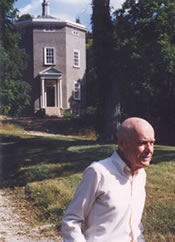Clay Lancaster, 1917 – 2000

A native of Lexington, Kentucky, Clay Lancaster (30 March 1917 – 25 December 2000) won recognition both regionally and internationally for his scholarship, creativity, and advocacy in a variety of fields.
Many knew him for his work in formal nineteenth- and twentieth-century American architecture, which included studies of architects and structures not only in Kentucky, but in New York and Massachusetts as well. With his study of The American Bungalow, he became known to a tremendous constituency of enthusiastic preservationists all across America.
The arts and ideas of the Far East were his second major enthusiasm. His 1963 title, The Japanese Influence in America, is perhaps his most widely-known book and remains a key text in its field.
He considered his work in cross-cultural and religious studies to be his most important.
In addition to works on architecture, oriental art, and philosophy, Clay Lancaster was a writer and illustrator of half a dozen books for children. These began with The Periwinkle Steamboat, published by Viking in 1961, soon followed by Michiko, set in Clay's Brooklyn.
Clay Lancaster also wrote a guidebook to New York's Prospect Park and another on Nantucket's early Far Out Island Railroad. In addition, he taught courses in art and architecture at the Metropolitan Museum, Columbia University, Transylvania University, the University of Louisville, and the University of Kentucky. He was a frequent lecturer on architecture, served widely as a consultant, and was an outspoken advocate for historic preservation.
He returned to Kentucky in 1978, continuing on as a writer and artist.
We have a short video, excerpted from a longer piece made for KET by Stan Petrey, about Clay Lancaster and Warwick.
The Warwick Foundation | P.O. Box 1183 | Lexington, KY 40588 | Phone: 859 865-4225 | E-mail: dce@qx.net
© 2023 The Warwick Foundation • warwickfoundation.org
